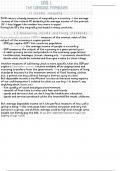Summary
Samenvatting The Economy - Economics (ECONOM01)
- Course
- Institution
- Book
Summary of parts of the book the economics. For example, for International Business students who study at Han University of Applied Science and who have a first-year economics exam. Includes all the stuff you need to know. || Summary of parts of the book the economics. For example, for Internationa...
[Show more]



